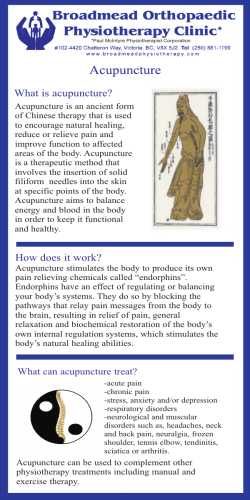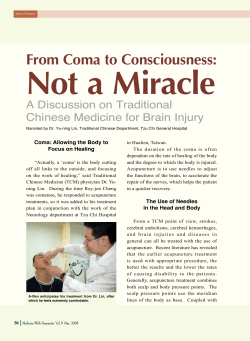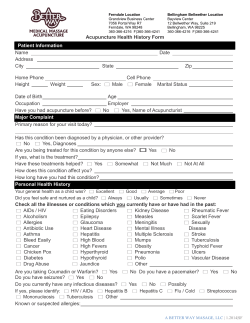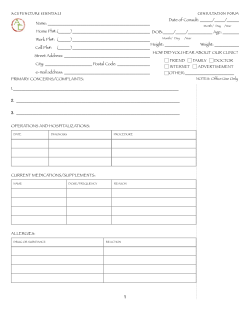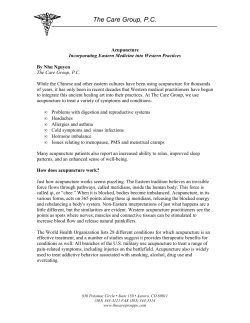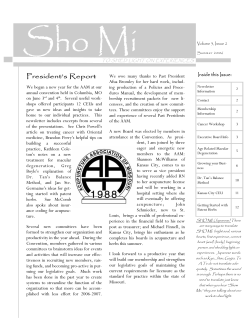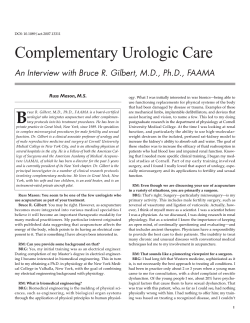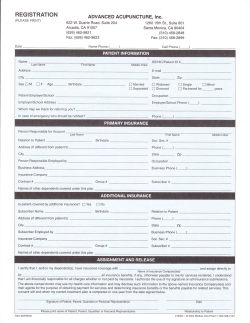
The Effects of Acupuncture on the Treatment of Perimenopausal Symptoms
The Effects of Acupuncture on the Treatment of Perimenopausal Symptoms Brian Grosam PhD., TCMD, LAc. American Academy of Acupuncture and Oriental Medicine Shandong University of Traditional Chinese Medicine Abstract Objective: To observe the clinical effects of acupuncture on treating perimenopausal symptoms and improve our understanding of the mechanisms behind the effects. Time and Location: The study was performed in 2008 at the American Academy of Acupuncture and Oriental Medicine, located in Roseville, Minnesota. Research Methods: 42 women applied to participate in the study. After a detailed initial intake, 11 women were excused for not meeting the requirements. The 31 remaining women were able to participate in the study. Of these 31 women, 6 women were disqualified for not completing the research. There were 25 women who met all of the qualifications, specifications and finished the 12-week research study. Inclusion Criteria: Women needed to be between the ages of 35-65; Show common symptoms of perimenopause including: Hot flashes, night sweating, sleep irregularities, heart discomfort or palpitations, anxiety, melancholy or depression, heavy or prolonged menses, irregular or ceasing of menses, vaginal irregularities, sexual problems, bladder irregularities, fatigue and weakness, arthralgia, etc. A key point was symptoms must have started gradually during the time of perimenopause, on average around the age of 45-55 years old. Lastly, participating women needed to commit to one acupuncture treatment per week for a 12-week treatment course. Exclusion Criteria: Women who did not meet the inclusion criteria or did not show enough evidence that their symptoms were a direct cause of perimenopause. Main Observation: The main observation item and index adopted was the Menopause Rating Scale (MRS), developed by the Berlin Center for Epidemiology and Health Research. Each woman involved in the research study filled out the MRS Scale at the beginning and end of the study. All scores were tallied, estimated, and the difference between the beginning and finished scores were evaluated. Treatment Methods: A precisely designed acupuncture point prescription to treat perimenopause symptoms was used. The prescription is easy to learn and administer, and if found effective, it could serve as a standard point prescription for all practitioners of Chinese and Western medicine. Auricular seed therapy was added to help maintain the effects of the treatment over the course of one-week span until the next treatment. Treatment was administered once per week for twelve weeks. The acupuncture needles were retained for 20 minutes during each treatment. After the body acupuncture, seed acupuncture therapy was applied and were retained for 3-5 days. Participants were instructed to press the seeds to induce sensation several times per day. Every week, the seeds were applied on the opposite ear, to keep fresh stimulation of the auricular points. Results: Treatment results were based and scored using the Menopause Rating Scale (MRS). The following graphs show the combined beginning and ending scores in the somato-vegetative sub-scale, psychological subscale, and urogenital sub-scale, along with the combined beginning and ending scores for the eleven specific symptoms. Results show an overall 63% relief in the somato-vegetative sub-scale, psychological sub-scale, while the urogenital sub-scale show 69% overall relief. It is worth noting the greatest individual relief was for bladder problems at 79% while the lowest was for hot flashes and night sweats at 59%. In conclusion, it can be seen that acupuncture has good therapeutic effectiveness at treating perimenopause symptoms. Conclusion: Acupuncture treatments can effectively relieve perimenopausal symptoms, carries low risk, minimally invasive, cost effective, and an excellent alternative to standard methods of treatment. 1 Results and Clinical Observations: Somato-Vegetative Symptoms Hot Flashes and Night Sweats Hot flashes and night sweats are common manifestations seen in perimenopausal women and were the chief complaints for most women in the study. The acupuncture treatments were able to reduce the intensity, number and length of hot flashes for most women, although at a gradual rate. Only a few women experienced fast relief after only 2-3 treatments. It was only until after 5-6 treatments when there was a noticeable shift. Intensity, number and length all seem to be relieved at an equal rate. Night sweats were relieved as well with great effectiveness and at the same rate as the hot flashes. By the end of the study, the effectiveness was a 59% reduction in severity of the hot flashes and night sweating manifestations. With review, it can be deduced that acupuncture can effectively relieve hot flashes of many patients, when due to the natural aging effects. However, it should be noted that when they are caused by a total hysterectomy or complicated by medications, long-term drug use, or chronic illness, the use of Chinese medicine in conjunction with acupuncture is suggested, along with careful diagnosis. Sleep Problems Sleep disorders, including trouble falling asleep, staying asleep, frequent waking at night and waking early in the morning is multifaceted in nature. All of these, in general, are categorized as insomnia in Chinese Medicine. The acupuncture treatments had a positive effect on the various sleep conditions, but to different degrees. For subjects with an increased difficulty in falling asleep, by the end of the study, in most cases, women were able to fall asleep much easier and without any complaints. What is more noteworthy was the waking in the middle of the night symptom, which was observed in many women in the study. Observation over the 3-month study showed a gradual, but slow improvement in this type of sleep problem. The overall sleep improvement was 62% for the 12-week study. In conclusion, over time acupuncture can slowly improve the various sleep problems that affect perimenopausal women. Heart Palpitations Heart discomfort and heart palpitations were noted for many women, but less than 25% noted it as significant discomfort. In Chinese medicine, literally any disruption in the body can affect the heart and thus cause these manifestations. During the study, heart problems were observed to occur more frequently during the evening time or at rest. At the end of the study, heart discomfort and heart palpitations were relieved significantly by 68%, and were virtually a non-problem for all women in the study. Joint and Muscular Discomfort Most women in the study noted minor aches and pains, arthralgia, fibromyalgia, or headaches to some degree on the MRS scale. Although, in the clinical setting, it is difficult to know for sure if these symptoms are truly associated with perimenopause. Women were excluded from participation in the study if the primary complaints were joint and muscular discomfort, but were not experiencing any of the other common perimenopausal symptoms. Women in the study noticed a decrease in joint and muscular discomfort. It is worth noting that joint and muscular discomfort disrupts sleep patterns, as well as adds to stress and emotional patterns, and increases the score levels. Thus, by simply treating women with a chief complaint of joint and muscular discomfort, we can indirectly treat other common symptoms seen during perimenopause. 2 Results and Clinical Observations: Psychological Symptoms Emotional Issues Depression, irritability and anxiety were closely observed and all of them were significant problems for women in the research study. The scores for these emotional issues were similar to hot flashes. In Chinese medicine there is a direct connection of the two groups. Depressive symptoms had the best treatment effectiveness at 64% reduction, due to the calming and soothing functions of acupuncture. Irritability had an effectiveness rate 62% reduction, while anxiety had the lowest effectiveness rate at 60% reduction in severity. Anxiety responded more slowly and gradually, similar to hot flashes. Fatigue, Mental and Physical Exhaustion Almost every woman in the study indicated problems with fatigue, mental or physical exhaustion. In fact, this group of manifestations received very high ratings on the MRS, even though it is not necessarily considered one of the chief complaints of perimenopause. The end results were remarkable with an effectiveness rate of 64% reduction. In fact, most women did not even consider these symptoms to be a problem by the end of the study and enjoyed increased energy and clear thinking. A final note was the speed and amount of relief, depended largely on the patient’s diet and exercise habits. Women with poor dietary habits or participated in little to no exercise, did not improve as well as women who had a balanced diet and exercise routine. Results and Clinical Observations: Urogenital Symptoms Urogenital Disorders Urogenital disorders encompasses sexual problems such as libido and satisfaction, bladder problems such as difficulty urinating, increased need to urinate or even incontinence, and vaginal disorders including dryness, burning, and intercourse difficulty. First of all that in America and with this age group of women, that some of the subjects had difficulty and were apprehensive with talking about these types of issues, especially with a male doctor. With this in mind, the scores on the (MRS) may have been slightly higher with a female doctor discussing these specific issues. It was observed that women with sexual problems also had vaginal dryness issues. The overall effectiveness for both vaginal and sexual problems was 63%. When discussing bladder issues, it was observed the women in the study overall suffered from an increases desire to urinate and frequency. Through the treatment course, there was 79% decrease in bladder disorders, showing significant success with acupuncture. 3 Results and Clinical Observations: Menstrual Irregularities It must be noted that even though menstrual irregularities are not listed and scored on the MRS scale, they are indeed one of the first and major concerns of women in perimenopause. Many women in the research suffered from menstrual problems, some with irregular menstrual cycles, shorter menses or just the fact that they were not having a period every month. It was assured to them that this is completely normal during perimenopause and by the end of the treatment sessions, most women had not complaints in this area. What is worth noting though, is the problem with some women who suffered from heavy, prolonged or constant bleeding. This can be a huge medical problem if the bleeding does not stop. This problem was observed with 4 women in the study and largely due to Qi deficiency in conjunction with kidney deficiency and internal heat due to stagnation. After the 12-week treatment course, the menstrual bleeding was controlled in all four women. Discussion One observation made during the study on the speed of recovery and the extent of relief, was largely dependent on the women’s diet, ability to deal with stress, rest and exercise habits. Typically, symptoms were relieved based on this equation: Mild symptoms: (1-6 treatments); Moderate symptoms: (6-12 treatments), Severe symptoms: (12+ treatments). Another observation was higher scores amongst women also suffering from fibromyalgia and arthritic pain. Third, the severity of symptoms amongst women suffering from pharmaceutical induced hot flashes, or hot flashes induced from hysterectomy, scored highest, and showed the slowest rates of improvement. Further investigation should be done in classifying and identifying the mechanisms inducing the various types of hot flashes. This will allow for direct and targeted treatments, savings in health expenses, decrease doctor office visits, and can remove the use of unnecessary and potentially harmful pharmaceutical treatments. Future Research 1.) Analysis of the Various Mechanisms that Cause or Induce Hot Flashes: • Natural Perimenopause Induced Hot Flashes • Total Hysterectomy Induced Hot Flashes • Pharmaceutical Induced Hot Flashes: (Hypothyroid Medications) • Other Treatment Induced Hot Flashes: (Cancer Treatment Radiation or Chemotherapy) • Infectious or Chronic Disease Induced Hot Flashes: (MS, Lyme, Bacteria Infections, Viral Infections) 2.) Analysis of Specific Acupuncture Points: Regulating the hypothalamus-pituitary-ovary adrenal axis. 3.) Is Auricular Acupuncture Therapy as Effective as Standard Body Acupuncture? 4.) The Effects of Acupuncture on Lab Tests: • Cardiovascular, Glucose, Lipids, CBC’s, Fluids & Electrolytes, Thyroid, Liver, Kidney, Mineral and Bone, Hemoglobin, DHEA, Testosterone, Estradiol, Fibrinogen, etc. 4
© Copyright 2025
